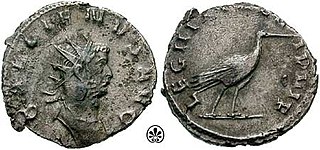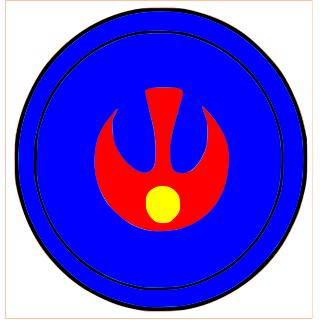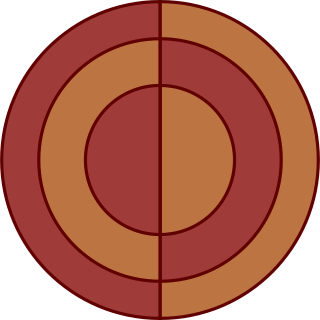Related Research Articles

Legio XIV Gemina was a legion of the Imperial Roman army, levied by Julius Caesar in 57 BC. The cognomen Gemina (Twinned) was added when the legion was combined with another understrength legion after the Battle of Actium. The cognomen Martia Victrix was added following their service in the Pannonian War c. AD 9 and the defeat of Boudicca in AD 61. The emblem of the legion was the Capricorn, as with many of the legions levied by Caesar.

Legio VIII Augusta was one of the oldest legions of the Imperial Roman army.

Legio XIII Gemina, in English the 13thTwin(s) Legion was a legion of the Imperial Roman army. It was one of Julius Caesar's key units in Gaul and in the civil war, and was the legion with which he crossed the Rubicon in January, perhaps the 10th, 49 BC. The legion appears to have still been in existence in the 5th century AD. Its symbol was the lion.

Legio III Italica was a legion of the Imperial Roman army founded in 165 AD by the emperor Marcus Aurelius for his campaign against the Marcomanni tribe. The cognomen Italica suggests that the legion's original recruits were drawn for the defence of Italy. The legion was still active in Raetia and other provinces in the early 5th century.

Legio IV Scythica, also written as Legio IIII Scythica, was a legion of the Imperial Roman army founded in c. 42 BCE by the Roman general Mark Antony, for his campaign against the Parthian Empire, hence its other cognomen, Parthica. The legion was still active in the Roman province of Syria in the early 5th century.

The Jovians and Herculians were the senior palatine imperial guard units under the rule of Roman Emperor Diocletian. They continued in existence thereafter as senior units in the field armies of the Western and Eastern Roman Empires.

Nikopol is a town in northern Bulgaria, the administrative center of Nikopol Municipality, part of Pleven Province, on the right bank of the Danube river, 4 kilometres downstream from the Danube’s confluence with the Osam river. It spreads at the foot of steep chalk cliffs along the Danube and up a narrow valley.

Legio II Armeniaca was a legion of the late Roman Empire. This legion may have been garrisoned in the Roman province of Armenia, but later, together with its twin, I Armeniaca, it was moved into the field army as a pseudocomitatensis legion. The legion is reported to have built a camp in Satala. According to Ammianus Marcellinus, in 360 AD. II Armeniaca was stationed in Bezabde with II Flavia Virtutis and II Parthica. When Shapur II besieged and conquered the city, killing many of the inhabitants. The II Armeniaca however, survived, since it is cited in the Notitia Dignitatum as being under the command of the Dux Mesopotamiae.
The comitatenses and later the palatini were the units of the field armies of the late Roman Empire. They were the soldiers that replaced the legionaries, who had formed the backbone of the Roman military since the late republic.

Legio V Macedonica was a Roman legion. It was probably originally levied in 43 BC by consul Gaius Vibius Pansa Caetronianus and Gaius Julius Caesar Octavianus. It was based in the Balkan provinces of Macedonia, Moesia and Dacia. In the Notitia Dignitatum records from beginning of the fifth century, the legion was still stationed in Dacia, with detachments stationed in the east and Egypt.

The Legio I Maximiana was a comitatensis Roman legion, probably created by Emperor Diocletian in 296 or 297 AD. The legion was named after Maximianus, a colleague of Diocletian. The I Maximiana was formed together with II Flavia Constantia, to garrison the newly created province Thebaidos, in Aegyptus. As well as protect it from neighboring tribes. Since no Legio I Maximiana is listed as being stationed at Thebes in the Notitia Dignitatum, the designation is interpreted more broadly as of the Thebaid in general. The legion is also known as Maximiana Thebanorum or Thebaeorum. The cognomen Maximiana originated from Maximian, Diocletian's colleague.

The Legio II Flavia Constantia was a comitatensis Roman legion, created by Diocletian or Galerius, probably in the years 293, 296 or 297.

Legio V Iovia was a Roman legion levied by Diocletian in the end of the 3rd century, and was still in service at the beginning of the 5th century. The cognomen of the legion refers to Jupiter, to whom Diocletian was devoted and identified.

Karak is one of the governorates of Jordan, located south-west of Amman, Jordan's capital. Its capital is Al-Karak. It s bordered by Madaba and the Capital governorates to the north, Ma'an Governorate to the east, Tafilah Governorate to the south, and the Dead Sea to the west.

Legio I Isaura Sagitaria was a pseudocomitatensis Roman legion. The legion was probably created by emperor Probus. It is possible that in the beginning it, together with the II and III Isaura, it was used to defend the Isauria region, The legion campaigned against the tribes of Cilicia. As its name suggests, its legionaries could be used also as archers, an uncommon feature for Roman legions. According to Notitia Dignitatum, in the beginning of the 5th century the I Isaura was under the command of the Magister Militum per Orientem.

Legio I Armeniaca was a pseudocomitatensis legion of the Late Roman Empire. The Legio I Armeniaca was likely created in the late 4th century by either Julian the Apostate or Diocletian. It is possible that the name of the legion could mean that it was originally part of the garrison of the Armeniac provinces. This unit, together with its twin legion II Armeniaca, appears to have been included in the imperial field army. It was based in Bezabde until the Persians captured the area in 360. The Legio I Armeniaca took part in Julian's invasion of the Sassanid Empire. The Notitia dignitatum records the legion as being under the command of the magister militum per Orientis around 400.
The Legio IV Italica was a legion of the Imperial Roman army raised in AD 231 by emperor Alexander Severus. The legion remained in existence as late as AD 400.

Legio I Flavia Constantia was a Roman legion, mentioned in the Notitia Dignitatum as a comitatenses unit stationed in the Eastern Empire.
The Legio I Illyricorum was a Roman Legion stationed in Qasr el-Azraq and Palmyra; it is mentioned in the Notitia Dignitatum. According to many ancient sources, it was stationed within the Eastern Half of the Roman Empire, under emperor Aurelian.
References
- ↑ "Notitia Dignitatum. In partibus Orientis". IntraText. XXXVII. Retrieved 2014-09-03.
- ↑ Parker, S., DARMC, R. Talbert, S. Gillies, J. Åhlfeldt, T. Elliott. "Places: 697643 (Betthorus)". Pleiades. Retrieved September 2, 2014.
{{cite web}}: CS1 maint: multiple names: authors list (link) - ↑ Lendering, Jona. "Legio IIII Martia". livius.org. Archived from the original on 2012-10-03. Retrieved 2014-09-03.
- ↑ Erdkamp, Paul (2008). A Companion to the Roman Army. John Wiley & Sons. p. 253. ISBN 9781405181440.
- ↑ G. Lankester Harding, 1959, The Antiquities of Jordan, p. 50.
